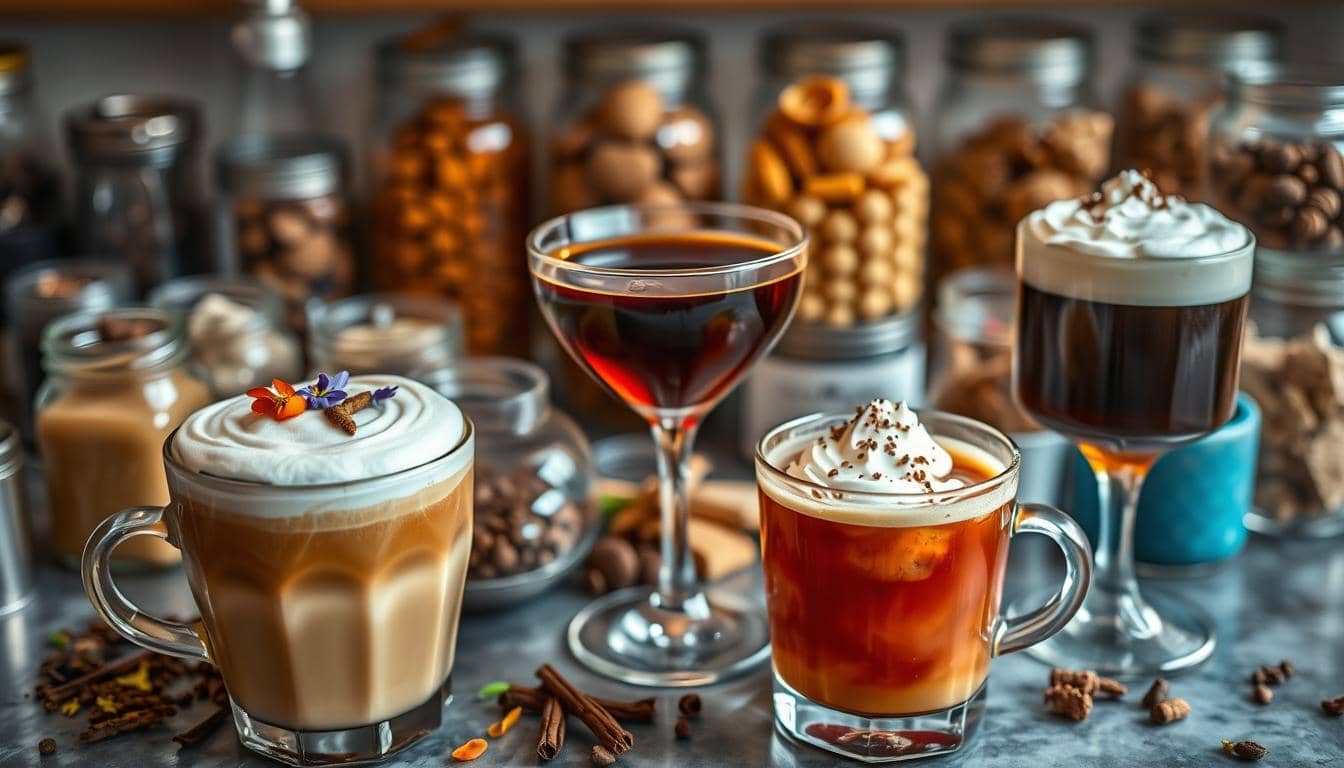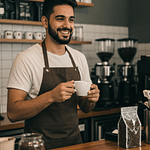Did you know 30% of coffee drinkers crave unique flavors so much they’re eager to try something new? Today, your morning coffee is more than just black or with cream. It’s a canvas for creativity.
Unique flavors like lavender honey lattes and gingerbread brews are changing coffee culture. A 25% shift toward cold brew and a 40% sales boost for fall favorites like spiced pumpkin lattes show this trend. At home, 15% of us mix matcha, fruit purees, or chocolate syrup into our coffee.
This shows coffee innovations aren’t just for baristas. From Japanese coffee jelly to coffee-infused jerky that lasts six weeks, coffee’s versatility turns every cup into an adventure.
Key Takeaways
- 30% of coffee drinkers seek unique flavors, driving demand for creative recipes.
- Cold brew’s 25% popularity and fall’s 40% sales spike show seasonal trends in flavor preferences.
- 15% of home brewers experiment with DIY coffee blends, blending flavors like matcha or caramel.
- Coffee’s culinary uses span meals—from breakfast shakes to coffee-braised meats—highlighting its versatility.
- 70% of millennials chase trendy ingredients like coconut cream, shaping modern coffee innovations.
Introduction
“Arabica beans, known for their sweeter taste, dominate the market with 60-70% of global production, while Robusta adds body but less flavor complexity,” say experts in the coffee industry.
Natural coffee flavors start with the bean’s origin. Ethiopian beans might burst with citrus and jasmine. Brazilian beans offer chocolatey notes. Flavored coffee adds more, like caramel or hazelnut. But, beans taste best within 2-4 weeks of roasting.
Trying new flavors is more than a trend. It’s about making your coffee personal. The grind affects the taste—finer for boldness, coarser for mildness. Even milk can change the flavor, like turning hazelnut into vanilla-cream. Finding the right balance of sweet, sour, bitter, or salty makes every sip special.
Next, we’ll explore how roasting and science shape these tastes. For now, remember: every bean has a story waiting to be discovered through its flavors.
The Science Behind Coffee Flavoring
Exploring coffee innovations and flavored coffee begins with the bean. The Specialty Coffee Association of America identified 110 traits of flavor, taste, and texture over 20 years ago. Roasting beans at 327°F unlocks their flavor potential by releasing sugars and acids.
- Ripeness matters: Only 60% of global coffee is Arabica, prized for nuanced flavors.
- Roast stages: Light roasts retain acidity, while dark roasts develop smoky notes as sugars caramelize.
- Flavor chemistry: Over 800 compounds create coffee’s aroma, from fruity esters to earthy aldehydes.
Creating flavored coffee involves adding essential oils or cold brew to roasted beans. Natural methods use fruit extracts, while coffee innovations try nitrogen-infused cold brew or spice-infused beans. The cupping process helps refine these blends by rating acidity, body, and aftertaste.
Tools like Crema.co’s Brew Log track flavor development. They connect bean origin to taste. The drying method also affects flavor: natural-processed beans are sun-dried for sweet notes, while washed beans have brighter acidity. Each step, from harvest to roast, influences the final cup’s aroma and taste.
Popular Traditional Coffee Flavors
When it comes to best coffee flavors, tradition is key in flavored coffee. Favorites like French Vanilla and Hazelnut are always in demand. They’re loved for their timeless charm. Let’s see why they’re always on coffee shop menus.
- French Vanilla: This flavor is creamy and sweet. It mixes vanilla’s warmth with coffee’s boldness. Its smooth taste makes it a favorite.
- Hazelnut: It has a nutty aroma and buttery notes. This flavor is perfect for autumn mornings or any time.
- Mocha: It’s a mix of chocolate and coffee. It’s sweet and appeals to those who love desserts.
- Caramel: It’s sweet and buttery. It’s loved in both drip coffee and lattes.
- Pumpkin Spice: It’s a fall favorite. It combines cinnamon and nutmeg for a cozy taste.
Whether enjoyed on its own or in a latte, these flavors show how simple tastes can please many. As we look at new trends, understanding these classics helps us see where innovation starts.
Unique Coffee Flavors Gaining Popularity
Cold brew sales are up, and 45% of U.S. drinkers want new tastes. Unique coffee flavors are changing what’s on café menus. Now, you can find everything from spice-infused brews to dessert-inspired drinks.
Cardamom Cold Brew
This Scandinavian brew combines cold brew’s smoothness with cardamom’s citrusy warmth. It has a peppery taste that goes well with nutty roasts. Adding a bit of cinnamon can make it even better.
Pear Syrup Lattes
Pear syrup gives latte a crisp apple taste. It balances out the espresso’s bitterness. Try it with oat milk for a creamy, refreshing drink.
Toffee Apple Pie Coffee
This coffee tastes like autumn pies, with caramelized toffee and cinnamon. It’s made with medium roasts, bringing out nutty flavors. Top it with whipped cream for a sweet treat.
Spiced Honey Cappuccino
Artisanal honeys like orange blossom or wildflower are the stars here. They’re mixed with nutmeg or clove for a warm, velvety drink. Manuka honey adds a floral touch.
These trends show a move towards bold, balanced flavors. With iced coffee now 32% of what people drink at home, it’s a great time to try new best coffee flavors. Your next cup could be a journey of flavors, beyond vanilla or hazelnut!
How to Create Your Own Coffee Flavor
Turn your kitchen into a coffee lab with easy coffee recipes. Pick a dark roast base for the best flavor absorption. Add natural ingredients like cinnamon or vanilla extract. Making coffee at home can save over $700 a year, making it a fun and cost-effective hobby.
- Mix equal parts sugar and water to make syrup bases. Add spices like nutmeg or citrus zest for unique coffee flavors.
- Infuse beans with a 50/50 mix of natural oils and grain alcohol. Store in a dark place for a week, shaking daily.
- Try extracts like vanilla or almond in small amounts. Mix with SweetLeaf’s calorie-free stevia for sweetness.
“The best unique coffee flavors come from quality beans,” says Cooper’s Cask Coffee. They’re known for single-origin roasts and have over 7,000 Amazon reviews. Their 5-degree roast-tasting process ensures precise flavors.
Test small batches to find the right balance. Add spices like cardamom to cold brew or mix caramel syrup for holiday treats. For layered tastes, try 15-second flavor infusions to avoid bitterness. Always store in airtight containers and use within 2–3 weeks for the best taste.
Want to add a seasonal twist? Try gingerbread for winter or mint chocolate for summer. Whether using store-bought syrups or homemade creamers, making it your own is key. Even store-bought beans can be improved with a dash of cinnamon or a drizzle of maple syrup.
The Role of Seasonal Ingredients in Coffee Flavors
Seasonal ingredients add a fresh twist to coffee recipes all year. By matching brews with the latest harvests, coffee fans get to enjoy timely and unique flavors. This method is not just a trend—it’s a smart way to be creative and eco-friendly.
- Spring: Brighten cups with floral lavender lattes or citrus-infused iced coffee.
- Summer: Cool down with tropical coconut cold brew or berry-infused iced drinks.
- Fall: Warm up with pumpkin spice blends or cinnamon-spiced lattes.
- Winter: Indulge in peppermint mochas or spiced eggnog coffee.
Coffee shops use seasonal trends for coffee innovations, with 30% of sales coming from seasonal drinks. Pumpkin spice is a big hit in fall, and peppermint sales soar in winter. These trends offer a chance for home brewers to try new things.
Seasonal ingredients also mean fresher, locally sourced options. Try adding apple cider to fall brews or rosewater in spring lattes. Pairing these flavors with brewing methods like cold brew in summer or French press in fall enhances the taste.
Whether you follow trends or create your own, seasonal ingredients keep coffee exciting. Try cinnamon and cloves for autumn or lemon zest in spring—your taste buds and the calendar will appreciate it.
Health Benefits of Natural Coffee Flavoring
Natural ingredients in flavored coffee can boost your health and keep taste exciting. Using cinnamon, cocoa, or herbs like turmeric adds antioxidants and nutrients. Unlike artificial syrups, natural options let you enjoy coffee innovations without extra calories or preservatives.
- Cinnamon: May help regulate blood sugar, ideal for those managing diabetes.
- Cocoa: Contains flavonoids that support heart health and reduce inflammation.
- Spices: Ginger and turmeric add anti-inflammatory benefits without refined sugars.
“Coffee is no longer classified as a carcinogen. Studies show moderate intake correlates with lower risks of certain cancers,” noted the World Health Organization in 2016.
Choose natural sweeteners like honey or stevia instead of sugary syrups. Try almond milk or oat milk for creaminess without saturated fats. Even small changes matter—like swapping vanilla extract for artificial vanilla syrup. Always check labels for hidden sugars or additives.
With coffee innovations in natural flavoring, you can enjoy a latte with matcha (rich in chlorophyll) or a chai-spiced brew with immune-boosting spices. Prioritize whole ingredients to keep your morning cup both tasty and nutritious.
Where to Find the Most Unique Coffee Flavors
Looking for the best coffee flavors? Check out local specialty roasters or online stores that buy directly from global farmers. These places often have rare flavors like Ethiopia’s floral jasmine or Colombia’s nutty caramel. Exploring different regions opens up a world of unique coffee flavors made by expert roasters.
Global places give coffee its unique taste. Ethiopia’s Harrar beans have a wine-like fruity taste, while Yirgacheffe has citrus and bergamot. Colombia’s SCAA-certified coffees are rich in caramel, and Costa Rica’s wet-processed beans are bright and citrusy. This shows that where coffee comes from really matters:
- Ethiopia: Harrar (fruity), Sidamo (floral)
- Colombia: Caramel, chocolate, nutty tones
- Costa Rica: Citrus, nutty, bright acidity
“SCAA-certified coffees ensure top-tier quality and unique flavor profiles.”
Online sites like Blue Bottle or Intelligentsia Coffee have carefully chosen coffees with natural ingredients. Go to local coffee festivals or events to try new blends before buying. Choose brands that are open about where they get their coffee and how it’s roasted to ensure quality.
Exploring coffee flavors with knowledge of their origins makes finding your favorite easier. Start with these sources, and let your taste buds lead you to the best coffee flavors out there.
Conclusion: Will Coffee Flavor Innovation Continue?
Coffee innovations are here to stay. The world’s love for unique coffee recipes is growing fast. Over 67% of coffee drinkers want new flavors, and companies are working hard to deliver. They’re experimenting with everything from cardamom cold brew to spiced honey blends.
The $9 billion flavored coffee market is growing by 4.04% every year. This shows there’s a lot of room for new ideas. Creativity is driving this change, making every step exciting.
Climate change and new technologies will shape the future of coffee. Farmers are facing challenges like losing land, but roasters are finding new ways to highlight unique flavors. They’re using air roasting, for example.
Micro-cafés are also getting high-tech, using drones and sensors for a fast and modern experience. Even as we focus on being more sustainable, bold flavors are still at the heart of it all.
Coffee lovers, this is your chance to explore. With specialty coffee making up 35% of the market, you can try unique blends like pear syrup lattes or toffee apple pie creations. Younger generations, who make up 30% of flavor sales, are pushing for more ethical and customized options.
Whether you visit a 2×2 micro-café or make your own coffee at home, you have the tools to create amazing brews. The future of coffee is bright, with 50% of roasters trying new methods and global flavors blending traditions.
Will innovation keep moving forward? Absolutely. With new methods and flavors coming in, the future is full of possibilities. The next big trend might be in your kitchen or a café using AI to make your coffee just right. The only thing that’s certain is that there’s always room for something new. So, what’s your next flavor adventure going to be?
FAQ
What are some unique coffee flavor trends we should know about?
Exciting trends include cardamom cold brew, pear syrup lattes, and spiced honey cappuccinos. They offer a new twist on traditional coffee.
How can we create unique coffee flavors at home?
Try flavored syrups, spices, and infused beans. Start simple and layer flavors to find the perfect mix.
What are the health benefits of using natural flavoring methods in coffee?
Ingredients like cinnamon and cocoa boost flavor and health. They help regulate blood sugar and offer antioxidants.
What traditional coffee flavors are popular around the world?
Vanilla, hazelnut, and caramel are timeless favorites. They’re great for creating more complex flavors.
Where can we find innovative coffee flavors outside of home brewing?
Look for them in specialty coffee shops, local roasters, and subscription services. Don’t miss out on coffee events and festivals!
How do seasonal ingredients affect coffee flavor creations?
Seasonal ingredients inspire unique flavors. For example, spring brings floral notes, while fall offers rich spices. This makes your coffee more exciting all year.
What’s the difference between natural and artificial flavoring methods?
Natural flavoring uses spices and extracts, while artificial uses synthetic compounds. Natural flavoring enhances taste and health benefits.
How do different brewing methods impact coffee flavor?
Brewing temperature, extraction time, and method change coffee flavor. Experimenting is key to getting the flavor you want.
How can we balance flavors when experimenting with coffee?
Begin with small amounts of extra ingredients. Some flavors can overpower others. It’s all about finding the right balance.










